Aman Canal Grande, Venice
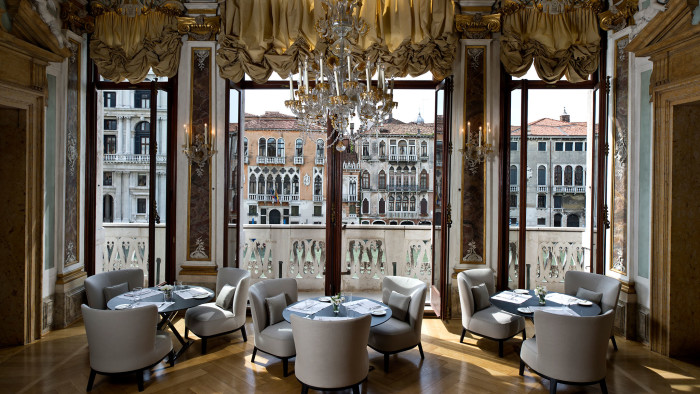
Simply sign up to the Life & Arts myFT Digest -- delivered directly to your inbox.
Almost as soon as your water taxi slips out from under the Rialto Bridge, heading west along the Grand Canal, the Palazzo Papadopoli looms large on the right, instantly recognisable by the two tall obelisks on its roof.
It’s an imposing sight, one of only eight palazzi monumentali in Venice, built in about 1560 and enough of a landmark to feature in a painting by Paolo Veronese (which hangs in Dresden’s Gemäldegalerie) and to have been drawn by JMW Turner (in Tate Britain). And, as of last month, it is the latest in the Aman Resorts chain.
That said, you will search in vain for any kind of name, branding or sign that it’s a hotel, either on its canal front or its entirely unassuming pedestrian entrance off the Campiello dei Meloni, five minutes’ walk from the Rialto. Even inside there’s no reception or concierge desk; Pier Flavio, the knowledgeable chief concierge, is identifiable only by the giveaway crosskeys on his lapel. For although the palazzo is a hotel, it is also a private house, and its owners and their five children continue to live on site.
I find its châtelaine, Bianca Arrivabene Valenti Gonzaga, dressed in skinny jeans and Converse trainers, curled up on a sofa in what she calls the ballroom but is now officially the dining room, a spectacular space with three immense windows that open on to a balcony overlooking the canal. A princess (of Savoia-Aosta) by birth and a countess by marriage, she has all the graces but none of the airs you might expect of someone so socially distinguished. She has lived here for 24 years with her husband, Giberto, who was baptised in the palazzo chapel and is a direct descendant of Nicolò and Angelo Papadopoli, the brothers after whom the palace is named. They themselves were the progeny of a merchant family so wealthy that during Napoleon’s occupation of Venice they paid 10 times as much tax as any other noble in the city.
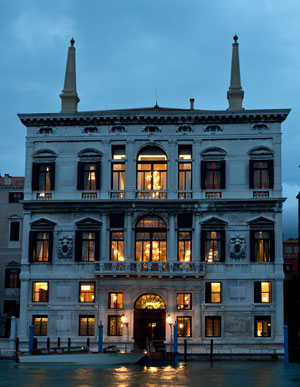
But family fortunes have a habit of ebbing away, and by the time Bianca and Giberto took up residence in 1989, the palazzo was crumbling and mostly rented out as offices. They set about restoring it while continuing to work (Giberto is a director of the insurance company Aon; Bianca is the representative for Christie’s in Venice); toyed with the idea of selling it until the deal fell through; rented it out for weddings, events, Biennale exhibitions and parties; and fretted about how to pay for its upkeep.
In 2006, a mutual friend suggested they meet Adrian Zecha, the Indonesian founder of Aman Resorts. It was not an obvious match. Amans don’t tend to be in cities and are mostly in Asia; most are designed and built from scratch. Moreover, they are known for a minimal aesthetic that could scarcely be further removed from the flamboyance of a 16th-century Venetian palazzo.
Nevertheless, Zecha saw how it might work as a hotel. “But I really didn’t want to sell,” says Giberto. “And most of all, we didn’t want to move. Adrian just smiled and said, ‘No problem. If you won’t sell it, we’ll rent it.’” So a contract was negotiated that allows Aman to manage a hotel on the site, while the family retain the freehold and continue to live on the top floor. And work began on converting a Renaissance palace into a 21st-century hotel. It was not a straightforward transformation – what with municipal bureaucracy, protected-building planning restrictions, financial crisis and the everyday complications of doing business in Italy – but it finally opened this June.
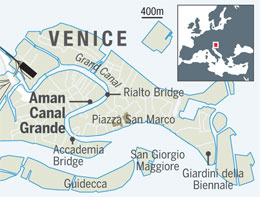
“I still find it strange to see people in my home who don’t know me,” says Giberto as he glances around the supremely ornate room, with its frescoes, its pier glasses, its swaths of gilded putti. The smaller dining room, to our left, has a ceiling by Giovanni Battista Tiepolo, one of three by the great 18th-century Venetian master in the palazzo.
Beauty is everywhere in Venice but I don’t know of a more impressive hotel in the city, nor one that remains so filled with the possessions of its owners. The Murano chandeliers are those installed by the Papadopoli brothers. The library, which has walls of 300-year-old Córdoba leather, groans with their books. At the centre of the principal salon on the fourth floor stands their concert grand piano. The dining rooms are hung with family portraits. “Only the ones we couldn’t sell,” quips Giberto.
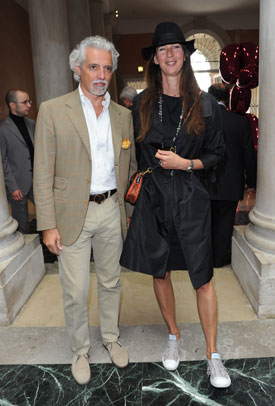
The designer Jean-Michel Gathy of Denniston Architects, a long-time Aman collaborator, decided not to compete with the palace’s all-pervading splendour. There may be subtly coloured Rubelli silks on the walls of the bar, dining rooms and in the heavenly Maddalena Suite but otherwise he has kept things simple. The furniture is mostly B&B Italia and his preferred colour in the 24 bedrooms is white – on the walls, leather bedheads, silk curtains and blinds – though perhaps to make the housekeeper’s life less of a hell, the upholstery on the low armchairs is grey.
Not that anyone goes to Venice to stay in their room (unless perhaps they’re shelling out €3,850 to stay in the Alcove Tiepolo Suite, with its sublime Chinoiserie murals and frescoed ceilings), to which end the hotel has put together a programme of enticing excursions accompanied by local writers, cooks and art historians, as well as after-hours private access to the Doge’s Palace, the clock tower in St Mark’s and the gardens of various privately owned palazzi and the monastery attached to Palladio’s Il Redentore church on Giudecca. Coincidentally I bumped into Bianca Arrivabene as she was showing a group of Aman guests around the must-see Biennale show, When Attitudes Become Form, at the Fondazione Prada, the last stop on a tour she’d put together of privately owned art collections. She greeted me as a friend and introduced me to the others – “This is Claire. She is staying at our house too” – and proved a delightful and insightful guide. The afternoon ended with an invitation to the family’s apartment in the palazzo and the offer of “a beer or a Negroni”.
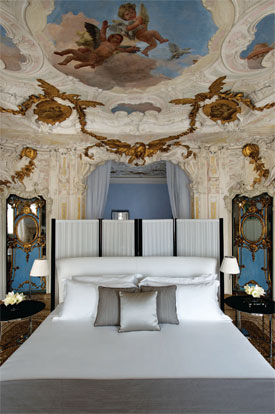
The Asian accent on the catering comes as a surprise, though why wouldn’t there be takers for the Japanese restaurant in its canal-front garden and the Thai menu in its main restaurant, not least among Venetian locals? Certainly I enjoyed a delicate dish of wild rice cooked in cuttlefish ink and served with a generous quantity of the thumb-sized cephalopods they call seppie, which but for the coriander and lemon grass could almost have been Venetian. And there are finely executed classic Italian dishes on the menu too, not least an outstanding carpaccio of beef with summer truffles. It’s also the sort of restaurant where, quite spontaneously, I found myself chatting to the other diners, both Aman-loyal tourists and locals.
Don’t be tempted to have breakfast here, though: the straightforward “Canal Grande” option, for which they charge €28 a head, consists of orange juice, a cappuccino and either a small, unexceptional croissant or two slices of toasted supermarket bread. This is also the first Aman I’ve stayed in that charges for soft drinks in its minibar and doesn’t leave carefully chosen texts or stories or thoughtful souvenirs by your bedside at turndown.
Still, it was early days when I stayed there, and I’m confident the glitches will shake down. The palazzo is stupendous, its owners enchanting, and their presence, together with the Aman insistence that guests need never have to sign for anything, really does give the impression that one has chanced on a house party in a grand and civilised Venetian home.
——————————————-
Claire Wrathall was a guest of Aman Canal Grande (www.amanresorts.com). Double rooms cost from €1,100 per night
——————————————-
Venice in peril: Swamped by the tide of tourism
In the window of the Farmacia Morelli on Campo San Bartolomeo, immediately south of the Rialto, there’s a dot-matrix counter that keeps track of the number of permanent residents in Venice. The day I passed, at the end of last month, it stood at 57,987. Next to it is a chart detailing its population over the centuries. In 1750, it stood at 140,000; in 1951 174,808. Since then it’s been in sharp decline.
Not so the number of tourists. Last year at least 6.4m people spent at least one night in commercial accommodation in the city, a number its ancient architecture and infrastructure are struggling to cope with, especially in the face of rising sea levels. More than that, as the journalist Anna Somers Cocks, who formerly chaired Venice in Peril, puts it: “Venetians are despairing of it continuing as a real community …as they see it abandoned to the tourist trade.”
In a piece headlined “The Coming Death of Venice” in The New York Review of Books that was the talk of the town during my visit, she proposes that the city should limit tourist numbers by introducing a ticketing system, and levy a €30 charge on each visitor. This would go towards a ringfenced fund that could be spent on maintaining the city.
Staying at the Aman, in slightly off-the-beaten-track San Polo, the smallest of the six sestieri (districts), one is blissfully unaware of the seething crowds. The hotel accommodates no more than 48 guests and most of its staff are from the Veneto, so its addition to Venice’s inventory of hotel rooms is unlikely in itself to make much difference.
Venture 15 minutes’ walk southeast to Saint Mark’s Square, however, and being here can very quickly cease to be a pleasure, especially if you coincide with the disgorgement of day-trippers from one of the 650 or so gigantic cruise ships that are tugged up the Giudecca canal and dock at the Stazione Marittima each year. On a single day in July 2011, Somers Cocks reports, six cruise ships carrying 35,000 passengers docked simultaneously. Just this knowledge gives one pause.
Yet of course people want to come here. There is no more beautiful city on earth, though neither is there a more fragile one.
Comments